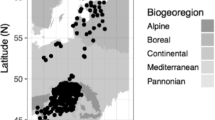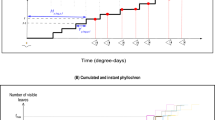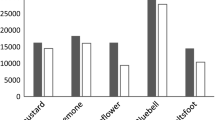Abstract
It is known from many studies that plant species show a delay in the timing of flowering events with an increase in latitude and altitude, and an advance with an increase in temperature. Furthermore, in many locations and for many species, flowering dates have advanced over the long-term. New insights using survival modeling are given based on data collected (1970–2010) along a 3000-km long transect from northern to eastern central Europe. We could clearly observe that in the case of dandelion (Taraxacum officinale) the risk of flowering time, in other words the probability that flowering occurs, is higher for an earlier day of year in later decades. Our approach assume that temperature has greater influence than precipitation on the timing of flowering. Evaluation of the predictive power of tested models suggests that Cox models may be used in plant phenological research. The applied Cox model provides improved predictions of flowering dates compared to traditional regression methods and gives further insights into drivers of phenological events.




Similar content being viewed by others
References
Ahas R, Aasa A (2006) The effects of climate change on the phenology of selected Estonian plant, bird and fish populations. Int J Biometeorol 51:17–26
Bauer S, Gienapp P, Madsen J (2004) The relevance of environmental conditions for departure decision changes en route in migrating geese. Ecology 89:1953–1960
Bewick V, Cheek L, Ball J (2004) Statistics review 12: Survival analysis. Crit Care 8:389–394
European Biological Diversity ETC (2006) The indicative map of european biogeographical regions: methodology and development. Technical report, National Museum of Natural History, France, http://www.eea.europa.eu/data-and-maps/data/biogeographical-regions-europe-1 http://www.eea.europa.eu/data-and-maps/data/biogeographical-regions-europe-1
Chambers LE, Altwegg R, Barbraud C, Barnard P, Beaumont LJ, Crawford RJM, Durant JM, Hughes L, Keatley MR, Low M, Morellato PC, Poloczanska ES, Ruoppolo V, Vanstreels RET, Woehler EJ, Wolfaardt AC (2013) Phenological changes in the Southern Hemisphere. PLoS ONE 8:e0075514
Cleland E, Chuine I, Menzel A, Mooney HA, Schwartz MD (2007) Shifting plant phenology in response to global change. Trends Ecol Evol 22:357–365
Cook BI, Terano A, Steiner A (2010) Ecological forecasting under climatic data uncertainty: a case study in phenological modeling. Environ Res Lett 5:044,014
Cortazar-Atauri I, Brisson N, JP G (2009) Performance of several models for predicting budburst date of grapevine (Vitis vinifera L.) Int J Biometeorol 53:317–326
Cox DR (1972) Regression models and life-tables. J Royal Stat Soc Ser B 34:187–220
Crepinsek Z, Zrnec C, Susnik A, Zust A (2008) Slovenian phenological observations. In: Nekovar J, Koch E, Kubin E, Nejedlik P, Sparks T, Wielgolaski F E (eds) COST Action 725 - The history and current status of plant phenology in Europe. COST Office, Brussels
DeCesare N, Hebblewhite M, Bradley M, Hervieux D, Neufeld L, Musiani M (2013) Linking habitat selection and predation risk to spatial variation in survival. J Anim Ecol 83:343– 352
Doi H (2008) Delayed phenological timing of dragonfly emergence in Japan over five decades. Biol Lett 4:388–391
Fu Y, Piao S, Zhao H, Jeong SJ, Wang Z, Vitasse Y, Ciaia P, Janssens I (2014) Unexpected role of winter precipitation in determining heat requirement for spring vegetation green-up at northern middle and high latitudes. Glob Chang Biol 20:3743–3755
Garcia-Mozo H, Galan C, Belmonte J, Bermejo D, Candaud P, Diaz de la Guardiae C, Elvira B, Gutierrez M, Jato V, Silva I, Trigo M, Valencia R, Chunie I (2009) Predicting the start and peak dates of the Poaceae pollen season in Spain using process-based models. Agric Forest Meteorol 149:256–262
Gienapp P, Hemerik L, Visser M (2005) A new statistical tool to predict phenology under climate change scenarios. Glob Chang Biol 11:600–606
Gienapp P, Hemerik L, Visser M (2010) Latitudinal variation in breeding time reaction norms in a passerine bird. J Anim Ecol 79:836–842
Gobiet A, Kotlarski S, Beniston M, Heinrich G, Rajczak J, Stoffel M (2014) 21st century climate change in the European Alps—a review. Sci Total Environ 493:1138–1151
Grisule G, Baksiene E (2008) The history and current status of phenological recording in Latvia. In: Nekovar J, Koch E, Kubin E, Nejedlik P, Sparks T, Wielgolaski F E (eds) COST Action 725 - The history and current status of plant phenology in Europe. COST Office, Brussels
Haylock MR, Hofstra N, Klein Tank AMG, Klok EJ, Jones PD, New M (2008) A European daily high-resolution gridded data set of surface temperature and precipitation for 1950–2006. J Geophys Res: Atmos 113. doi:10.1029/2008JD010201
Hodzic S, Voljevica A (2008) Phenology in Bosnia and Hercegovina. In: Nekovar J, Koch E, Kubin E, Nejedlik P, Sparks T, Wielgolaski F E (eds) COST Action 725 - The history and current status of plant phenology in Europe. COST Office, Brussels
Hofstra N, Haylock M, New M, Jones P (2009) Testing e-obs European high-resolution gridded data set of daily precipitation and surface temperature. J Geophys Res 114:D211011
IPCC (2007) Technical summary. Cambridge University Press, Cambridge
Kovats RS, Valentini LM, Bouwer E, Georgopolou D, Jacob E, Rounsevell M, Soussana JF (2014) Europe. In: Barros V R, Field C B, Dokken D J, Mastrandrea M D, Mach K J, Bilir T E, Chatterjee M, Ebi K L, Estrada Y O, Genova R C, Girma B, Kissel E S, Levy A N, MacCracken S, Mastrandrea P R, White L L (eds) Climate change 2014: impacts, adaptation, and vulnerability. PartB: Regional Aspects. Contribution of Working Group II to the Fifth Assessment Report of the Intergovernmental Panel on Climate Change. Cambridge University Press, Cambridge
Jatczak K, Walawender J (2009) Average rate of phenological changes in Poland according to climatic changes. Adv Sci Res 3:127–131
Jong R, Bruin S (2012) Linear trends in seasonal vegetation time series and the modifiable temporal unit problem. Biogeosciences 9:71–77
Kalvane G, Romanovskaja D, Briede A, Baksiene E (2009) Influence of climate change on phenological phases in Latvia and Lithuania. Clim Res 39:209
Kaplan EL, Meier P (1958) Nonparametric estimation from incomplete observations. J Amer Stat Assoc 53:457–481
Kleinbaum D, Klein M (2012) Survival analysis: a self-Learning text, 3rd edn. Statistics for Biology and Health, Springer
Körner C, Basler D (2010) Phenology under global warming. Science 327:1461–1462
Kubin E, Kotilainen E, Poikolainen J, Hokkanen T, Nevalainen S, Pouttu A, Karhu J, Pasanen J (2007) Monitoring instructions of the Finnish national phenological network. Technical report. Finnish Forest Research Institute (Metla), Muhos Research Unit
Meier U (2001) BBCH-monograph: growth stages of mono- and dicotyledonous plants. Technical Report, 2nd edn. Federal Biological Research Centre for Agriculture and Forestry
Menzel A, Sparks TH, Estrella N, Koch E, Aasa A, Ahas R, Alm-Kuebler K, BissolliI P, Braslavska O, Briede A, Chmielewski FM, Crepinsek Z, Curnel Y, Dahl A, Defila C, Donelly A, Filella Y, Jatczak K, Mage F, Mestre A, Nordli A, Penuelas J, Pirinen P, Remisova V, Scheifinger H, Striz M, Susnik A, Van Vliet AJH, Wielgolaski FE, Zach S, Zust A (2006) European phenological response to climate change matches the warming pattern. Glob Chang Biol 12:1969–1976
Migliavacca M, Sonnentag O, Keenan TF, Cescatti A, O‘Keefe J, Richardson AD (2012) On the uncertainty of phenological responses to climate change, and implications for a terrestrial biosphere model. Biogeosciences 9:2063–2083
Mikkonen S, Laine M, Mäkelä H, Gregow H, Tuomenvirta H, Lahtinen M, Laaksonen A (2015) Trends in the average temperature in Finland, 1847–2013. Stoch Environ Res Risk Assess 29:1521–1529
Niedz̀wiedz̀ T, Jatczak K (2008) History of phenology phenology in Poland. In: Nekovar J, Koch E, Kubin E, Nejedlik P, Sparks T, Wielgolaski F E (eds) COST Action 725 - The history and current status of plant phenology in Europe. COST Office, Brussels
Pau EM, Wolkovich EM, Cook BI, Davies TJ, Kraft NJB, Bolmgren K, Betancourt JL, Cleland EE (2006) Predicting phenology by integrating ecology, evolution and climate science. Glob Chang Biol 17:3633–364
Popovic T, Drljevic M (2008) History and current status of phenology in Montenegro. In: Nekovar J, Koch E, Kubin E, Nejedlik P, Sparks T, Wielgolaski FE (eds) COST Action 725 - The history and current status of plant phenology in Europe. COST Office, Brussels
Development Core Team R (2016) R: A language and environment for statistical computing r foundation for statistical computing, Vienna, Austria, http://www.R-project.org
Remisovà T, Nejedlik P (2008) History and present observations in slovak plant phenology. In: Nekovar J, Koch E, Kubin E, Nejedlik P, Sparks T, Wielgolaski F E (eds) COST Action 725 - The history and current status of plant phenology in Europe. COST Office, Brussels
Rodriguez G (2007) Lecture notes on generalized linear models chapter 7: survival models. Technical report, Princeton University, http://data.princeton.edu/wws509/notes/
Roekaerts M (2002) The biogeographical regions map of Europe: basic principles of its creation and overview of its development. Technical report, European Topic Centre Nature Protenction and Biodiversity, European Environment Agency
Romanovskaja D, Baksiene E (2008) Phenological investigations in Lithuania. In: Nekovar J, Koch E, Kubin E, Nejedlik P, Sparks T, Wielgolaski FE (eds) COST Action 725 - The history and current status of plant phenology in Europe. COST Office, Brussels
Ruml M, Milatovic D, Vulic T, Vukovic A (2011) Predicting apricot phenology using meteorological data. Int J Biometeorol 55:723–732
Schaber J (2012) Pheno: auxiliary functions for phenological data analysis. R Foundation for Statistical Computing; package version 1.6
Schaber J, Badeck FW (2002) Evaluation of methods for the combination of phenological time series and outlier detection. Tree Physiol 22:973–982
Schwartz MD, Ahas R, Aasa A (2006) Onset of spring starting earlier across the Northern Hemisphere. Glob Chang Biol 12:343–351
Sparks T, Menzel A (2002) Observed changes in season: an overview. Int J Climatol 22:1715–1725
Stenseth NC, Ottersen G, Hurrell J, Mysterud A, Lima M, Chan K, Yoccoz N, Adlandsvik B (2003) Studying climate effects on ecology through the use of climate indices: the North Atlantic Oscillation, El Nino Southern Oscillation and beyond. Proc Royal Soci London Ser B: Biol Sci 270:2087–2096
Szabò B, Vincze E, Czùcz B (2016) Flowering phenological changes in relation to climate change in Hungary. Int J Biometeorol 60:1347–1356
Szalai S, Bella S, Nè—meth A, Dunay S (2008) History and present observations in slovak plant phenology. In: Nekovar J, Koch E, Kubin E, Nejedlik P, Sparks T, Wielgolaski F (eds) COST Action 725 - The history and current status of plant phenology in Europe. COST Office, Brussels
Therneau T (2015) Package: survival—survival analysis. R Foundation for Statistical Computing; package version 2.38-3
Tookey F, Battey N (2010) Temperate flowering phenology. J Exp Bot 61:2853–2862
Visser ME, Holleman LJM, Gienapp P (2006) Shifts in caterpillar biomass phenology due to climate change and its impact on the breeding biology of an insectivorous bird. Oecologia 147:164–172
Vucetic̀ V, Vucetic̀ M, Loncar Z (2008) History and present observations in Croatian plant phenology. In: Nekovàr J, Koch E, Kubin E, Nejedlik P, Sparks T, Wielgolaski F E (eds) COST Action 725 - The history and current status of plant phenology in Europe. COST Office, Brussels
Walther GR, Post E, Convey P, Menzel A, Parmesan C, Beebee TJC, Fromentin JM, Hoegh-Guldberg O, Bairlein F (2002) Ecological responses to recent climate change. Nature 416: 389–39
Way D (2011) Tree phenology responses to warming: spring forward, fall back? Tree Physiol 31:469–471
Wickham H (2009) ggplot2: Elegant graphics for data analysis. Springer-Verlag, New York. http://ggplot2.org
Wielgolaski F (2001) Phenological modifications in plants by various edaphic factors. Int J Biometeorol 45:196– 202
Williams T, Bourgeon S, Cornell A, Ferguson L, Fowler M, Fronstin R, Love O (2015) Mid-winter temperatures, not spring temperatures, predict breeding phenology in the European starling Sturnus vulgaris. Royal Soc Open Sci 2:140301
Zeng H, Jia G, Epstein H (2015) Recent changes in phenology over the northern high latitudes detected from multi-satellite data. Environ Res Lett 6:045508
Acknowledgments
We acknowledge the E-OBS dataset from the EU-FP6 project ENSEMBLES (http://ensembles-eu.metoffice.com) and the data providers in the ECA&D project (http://www.ecad.eu).
We would like to thank the NS-Pheno Team (group of researchers) who provided the data that we used to build up a north-south transect-based phenological database for a major of central and eastern European countries. In person, we thank E. Bakšienè (Voke Branch of the Lithuanian Research Centre for Agriculture and Forestry), H. Gregow (Finnish Meteorological Institute), S. Hodzic (Federal Hydrometeorological Institute of Federation of Bosnia and Herzegovine), K. Jatczak (Centre for Polands̀ Climate Monitoring), G. Kàlvàne (University of Latvia), E. Kubin (Natural Resources Institute Finland), P. Nejedlik (Slovak Hydrometeorological Institute), T. Niedz̀wiedz̀ (University of Silesia), V. Palm (University of Tartu), T. Popovic (Hydrometeorological Institute of Montenegro), D. Romanovskaja (Voke Branch of the Lithuanian Research Centre for Agriculture and Forestry), H. Simola (Finnish Meteorological Institute), Z. Snopkovà (Slovak Hydrometeorological Institute), S. Stevkova (Hydrometeorological Institute of Macedonia), V. Vučetić (Croatian Meteorological and Hydrological Service) and A. žust (Environmental Agency of the Republic of Slovenia). And finally, we want to thank J. Terhivuo (Finnish Museum of Natural History), who provided us the data—too unfortunate he cannot see these results published.
Author information
Authors and Affiliations
Corresponding author
Rights and permissions
About this article
Cite this article
Templ, B., Fleck, S. & Templ, M. Change of plant phenophases explained by survival modeling. Int J Biometeorol 61, 881–889 (2017). https://doi.org/10.1007/s00484-016-1267-z
Received:
Revised:
Accepted:
Published:
Issue Date:
DOI: https://doi.org/10.1007/s00484-016-1267-z




